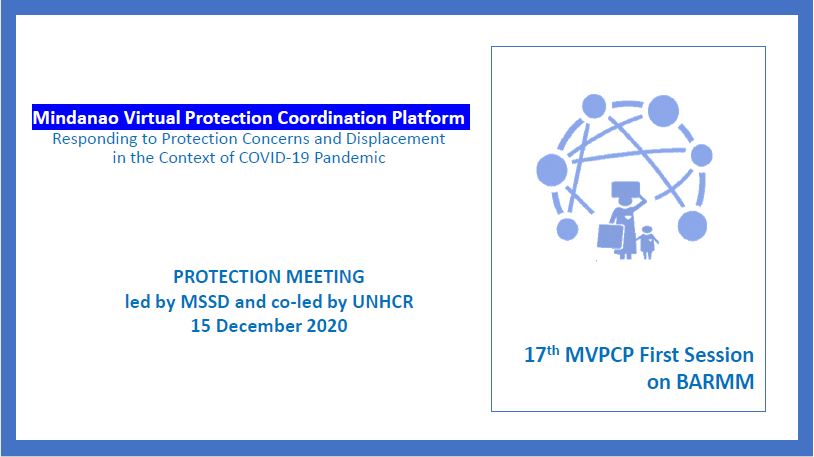17th Mindanao Virtual Protection Coordination Platform (MVPCP)
Cover Message
There are 91,002 individuals currently displaced in BARMM, with majority of the displaced persons belonging in Lanao del Sur comprising 86% of the total number. Armed conflict and clan feud account for recent and protracted displacements due to warring factions and armed encounters between the government and hostile groups occurred during the reporting period.
For non-BARMM areas, 182,932 individuals remain displaced. This is a slight decrease from the recorded 183,962 displaced persons in the last reporting period. The majority number of displacements comes from Region XI, which embraces 63% of the total figure reported. MSSD BARMM presented the status report of disaster in Maguindanao. The province of Maguindanao had encountered series of armed conflict wherein there were reported casualties and families who were forced to seek refuge in different evacuation sites. Their livelihood activities were hampered, exacerbating their living conditions during the COVID-19 pandemic. There is a call for more collaboration, coordination and sharing of activities to all humanitarian actors in relation to the current Maguindanao situation. Partners are requested to share their respective activities in the pipeline and report to MSSD and other protection partners in order to prevent confusion and duplication of activities. MSSD Maguindanao shall consolidate all activities conducted and other planned activities.
For Protection updates on the island provinces, there are additional 66 displaced families outside Tipo-Tipo Municipality last August (from the recorded 207 displaced families within the municipality). In Sumisip Municipality, there are 227 displaced families (Brgy. Baiwas- 34 families; Brgy. Guiong- 67 families; Brgy. Pamatsaken- 53 families; Brgy. Mahatallang- 73 families). This figure is in addition to the 180 families previously reported. In Sulu, there are remaining 652 displaced families (protractedly displaced since 2017), and new displacement occurred in Siasi Municipality in Sulu (40 families displaced). As of 27 November, said families have returned to their places of origin. There are no new reported displacements in Tawi-Tawi, and for Lanao del Sur, displacement updates shall be provided in the next MVPCP meeting.
DSWD Regional Offices are continuously monitoring the number of displaced families temporarily seeking shelter in camps and evacuation centers (ECs) and their urgent needs. Social disorganization occurred in Polomolok, South Cotabato last 13 November 2020 when the PNP served warrant of arrest to an alleged member of Daulah Islamiyah, causing panic to the residents of Brgy. Koronadal Proper. Said incident was brief since the residents were pacified after the warrant was served. Accordingly, 120 families (600 individuals) fled to search for safer grounds but were able to return to their residences shortly after the service of warrant. In Tandag City, augmentation support for the IDPs and the LGU has commenced, providing family food packs to the displaced families, and they have already returned to their places of origin. For IDPs in Torel, there are 16 families currently staying in a school (Torel Islamic School Academy), while other families are home-based. In Purok Lumundot, Iligan City, there are remaining 17 displaced families residing with their families and some are home-based. In Tomas Cabili, Iligan City, there are 15 displaced families currently staying in a school, but they have to relocate soon since the school shall undergo rehabilitation. In Upper Hinaplanon, there are 11 displaced families, including the Sultan of Marawi. With the rest of Marawi, 600 displaced families in different barangays in LAA and MAA were provided with livelihood programs such as transportation, among others. Provision of cash assistance is also targeted to be conducted through TFBM. For more information, please download the 17th MVPCP Presentation.
UNHCR Philippines is continuously working closely with key government agencies and protection partners in responding to the needs of those forcibly displaced, ensuring that the protection is at the centrality of all humanitarian responses and remaining steadfast in its commitment to stay and deliver.

